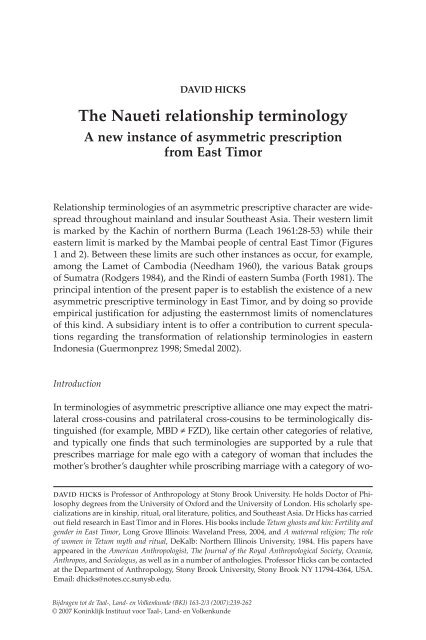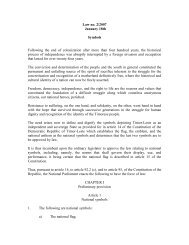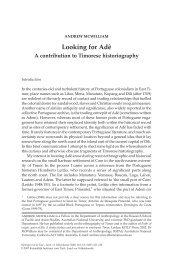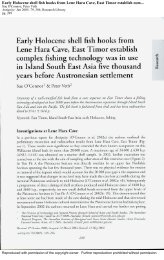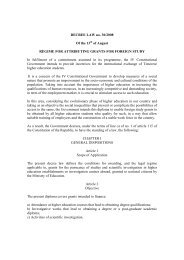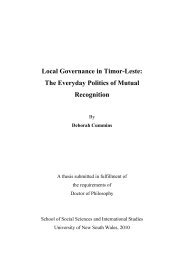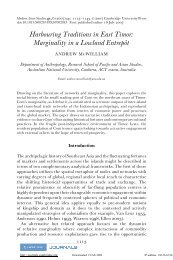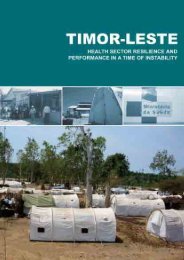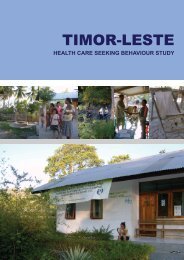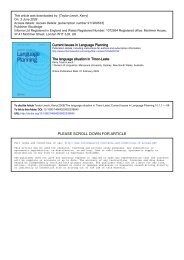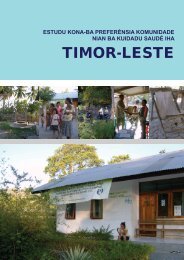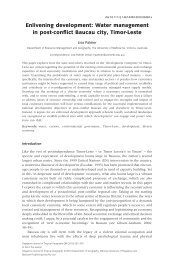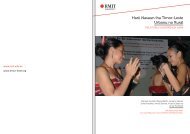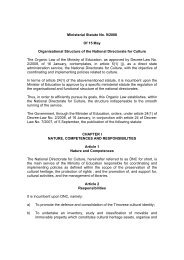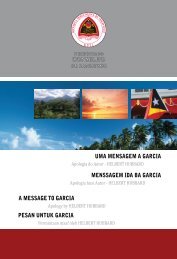The Naueti relationship terminology - Secretaria de Estado da Arte e ...
The Naueti relationship terminology - Secretaria de Estado da Arte e ...
The Naueti relationship terminology - Secretaria de Estado da Arte e ...
You also want an ePaper? Increase the reach of your titles
YUMPU automatically turns print PDFs into web optimized ePapers that Google loves.
DAVID HICKS<br />
<strong>The</strong> <strong>Naueti</strong> <strong>relationship</strong> <strong>terminology</strong><br />
A new instance of asymmetric prescription<br />
from East Timor<br />
Relationship terminologies of an asymmetric prescriptive character are wi<strong>de</strong>spread<br />
throughout mainland and insular Southeast Asia. <strong>The</strong>ir western limit<br />
is marked by the Kachin of northern Burma (Leach 1961:28-53) while their<br />
eastern limit is marked by the Mambai people of central East Timor (Figures<br />
1 and 2). Between these limits are such other instances as occur, for example,<br />
among the Lamet of Cambodia (Needham 1960), the various Batak groups<br />
of Sumatra (Rodgers 1984), and the Rindi of eastern Sumba (Forth 1981). <strong>The</strong><br />
principal intention of the present paper is to establish the existence of a new<br />
asymmetric prescriptive <strong>terminology</strong> in East Timor, and by doing so provi<strong>de</strong><br />
empirical justification for adjusting the easternmost limits of nomenclatures<br />
of this kind. A subsidiary intent is to offer a contribution to current speculations<br />
regarding the transformation of <strong>relationship</strong> terminologies in eastern<br />
Indonesia (Guermonprez 1998; Sme<strong>da</strong>l 2002).<br />
Introduction<br />
In terminologies of asymmetric prescriptive alliance one may expect the matrilateral<br />
cross-cousins and patrilateral cross-cousins to be terminologically distinguished<br />
(for example, MBD ≠ FZD), like certain other categories of relative,<br />
and typically one finds that such terminologies are supported by a rule that<br />
prescribes marriage for male ego with a category of woman that inclu<strong>de</strong>s the<br />
mother’s brother’s <strong>da</strong>ughter while proscribing marriage with a category of wo<strong>da</strong>vid<br />
hicks is Professor of Anthropology at Stony Brook University. He holds Doctor of Philosophy<br />
<strong>de</strong>grees from the University of Oxford and the University of London. His scholarly specializations<br />
are in kinship, ritual, oral literature, politics, and Southeast Asia. Dr Hicks has carried<br />
out field research in East Timor and in Flores. His books inclu<strong>de</strong> Tetum ghosts and kin: Fertility and<br />
gen<strong>de</strong>r in East Timor, Long Grove Illinois: Waveland Press, 2004, and A maternal religion; <strong>The</strong> role<br />
of women in Tetum myth and ritual, DeKalb: Northern Illinois University, 1984. His papers have<br />
appeared in the American Anthropologist, <strong>The</strong> Journal of the Royal Anthropological Society, Oceania,<br />
Anthropos, and Sociologus, as well as in a number of anthologies. Professor Hicks can be contacted<br />
at the Department of Anthropology, Stony Brook University, Stony Brook NY 11794-4364, USA.<br />
Email: dhicks@notes.cc.sunysb.edu.<br />
Bijdragen tot <strong>de</strong> Taal-, Land- en Volkenkun<strong>de</strong> (BKI) 163-2/3 (2007):239-262<br />
© 2007 Koninklijk Instituut voor Taal-, Land- en Volkenkun<strong>de</strong>
IRIAN<br />
JAYA<br />
Arnhem Land<br />
SABAH<br />
Flores<br />
Sumba<br />
Figure 1. East Timor<br />
East Timor<br />
SARAW AK<br />
VIETNAM<br />
JAVA<br />
MALAYA<br />
SUMATRA<br />
Sumatra
W<br />
N<br />
S<br />
E<br />
14<br />
0 miles 50<br />
0 kilometres 60<br />
13<br />
7<br />
9<br />
15<br />
8<br />
10<br />
4<br />
5<br />
6a<br />
2<br />
3<br />
3<br />
6c<br />
11<br />
12<br />
6b<br />
1 Fataluku 7 Galoli<br />
2 Makassai 8 Mambai<br />
3 <strong>Naueti</strong> 9 Toko<strong>de</strong><br />
4 Walmaq 10 Ema<br />
5 Kairui 11 Bunak<br />
6 Tetum 12 Atoni<br />
6a Eastern Tetum 13 Ataúro groups<br />
6c Northern Tetum<br />
Western Tetum<br />
15 I<strong>da</strong>te<br />
6b Southern Tetum } 14 Helong<br />
Figure 2. Principal ethnolinguistic groups on Timor<br />
1
242<br />
David Hicks<br />
man that inclu<strong>de</strong>s the father’s sister’s <strong>da</strong>ughter. In many instances the structure<br />
of the <strong>terminology</strong> and concomitant marriage rule converges with institutional<br />
arrangements ‘on the ground’, so that male ego’s <strong>de</strong>scent group contracts affinal<br />
alliances with specified <strong>de</strong>scent groups (‘wife-givers’) that provi<strong>de</strong> his own<br />
group with wives, and other – clearly distinguished – specified <strong>de</strong>scent groups<br />
(‘wife-takers’) that receive his own group’s female kin (for example, sisters, father’s<br />
sisters, and <strong>da</strong>ughters) as wives. <strong>The</strong> respective statuses of wife-giver and<br />
wife-taker are exclusive. Wife-giving <strong>de</strong>scent groups may not receive women<br />
from ego’s <strong>de</strong>scent group nor do ego’s wife-taking partners provi<strong>de</strong> his own<br />
<strong>de</strong>scent group with wives. In contrast, in a symmetric <strong>terminology</strong> of prescription<br />
(or ‘two-section’ system) both matrilateral cross-cousins and patrilateral<br />
cross-cousins are conjoined into a single category (for example, MBD = FZD)<br />
and the rule of marriage may permit marriage with either. However, in some<br />
instances, although a symmetric <strong>terminology</strong> is employed, there may still be a<br />
prohibition against marriage between male ego and his female patrilateral crosscousin,<br />
with the result that the same triadic structure of affinal alliances, that is,<br />
wife-giver/ego’s <strong>de</strong>scent group/wife-taker, that one finds with a <strong>terminology</strong> of<br />
asymmetric prescriptive alliance, is in force. <strong>The</strong> (symmetric) <strong>terminology</strong> and<br />
the (asymmetric) alliance system are thus disjunctive. This heterology recurs<br />
in several other combinations, for example, asymmetric alliance accompanied<br />
by a non-prescriptive <strong>terminology</strong> (Hicks 1987) or a <strong>terminology</strong> of asymmetric<br />
prescriptive alliance unaccompanied by asymmetric alliance (Barnes 1974).<br />
Instances of these and other combinations are well-displayed in eastern Indonesia,<br />
which, since F.A.E. van Wou<strong>de</strong>n published his Sociale structuurtypen in <strong>de</strong><br />
Groote Oost in 1935, has gained recognition as an area in which the changes are<br />
rung on a number of variations and combinations of <strong>terminology</strong> and alliance.<br />
In particular, East Timor (Figures 1 and 2), with approximately fifteen<br />
ethnolinguistic groups within a relatively small region, offers an unusually<br />
promising laboratory for the comparative study of these variations and combinations,<br />
for while asymmetric alliance is so prominent and pervasive a feature<br />
of the social organizations of almost all the populations of East Timor as to be<br />
consi<strong>de</strong>red virtually their <strong>de</strong>fining feature, we find it combined with all manner<br />
of nomenclatures. Although notable instances also occur on the islands of<br />
Sumba and Flores, as well as in the western half of Timor, in East Timor the<br />
presence of the barlaque (as the institution is wi<strong>de</strong>ly called) is so ubiquitous<br />
that to <strong>da</strong>te only in one small area of the country is it known not to be practised.<br />
Even after twenty-four years of occupation by the military forces of the<br />
From the perspective of female ego the prescriptions and proscriptions are the reverse, that is,<br />
marriage with a category of male that inclu<strong>de</strong>s father’s sister’s son being enjoined and marriage<br />
with a category of male that inclu<strong>de</strong>s mother’s brother’s son being forbid<strong>de</strong>n.<br />
In the Viqueque subdistrict in Viqueque district among certain Tetum-speaking communities<br />
(Hicks 2004).
<strong>The</strong> <strong>Naueti</strong> <strong>relationship</strong> <strong>terminology</strong> 243<br />
Republic of Indonesia, a period atten<strong>de</strong>d by intense ‘mo<strong>de</strong>rnization’ of social<br />
norms, this perduring institution continues to direct the social lives, harness the<br />
cultural energies, and focus the psychological resources of its people. In<strong>de</strong>ed,<br />
so powerful an influence does the barlaque continue to exercise even to<strong>da</strong>y, that<br />
the massive expenditure of economic resources it entails ren<strong>de</strong>rs ‘matrilateral<br />
cross-cousin’ marriage a lightening rod for strictures from some mo<strong>de</strong>rn-min<strong>de</strong>d<br />
Timorese aware of the profound discrepancy between the economic status<br />
of a nation enmeshed in poverty and the vibrancy of an institution in which<br />
the giving of dozens of buffaloes, the prime component of bri<strong>de</strong>wealth, is commonplace<br />
at marriage. And buffaloes are but one component of the total set of<br />
marital prestations. <br />
For several years now I have been analysing Timorese <strong>relationship</strong> terminologies<br />
with a view to eliciting their structural characteristics and discerning<br />
their common features. Results thus far indicate that although the institution<br />
of asymmetric alliance is itself virtually ubiquitous among the island’s populations,<br />
the same constancy is not apparent in their terminologies. Thus, whereas<br />
the people speaking Bunak, Ema, Mambai, Kairui, Makassai, and Fataluku,<br />
as well as most Tetum, practise asymmetric alliance as an institution, one ethnic<br />
group (the Bunak (Hicks 1987)) accompanies it with a non-prescriptive <strong>terminology</strong>;<br />
three (Atoni (Cunningham 1967), Northern Tetum (Hicks 1981, 1989)<br />
and Fataluku 10 ) with symmetric prescriptive terminologies; two (Ema (Hicks<br />
1986) and Mambai (Hicks 1978)) with asymmetric prescriptive terminologies;<br />
and two (Kairui (Hicks 1973, 1990 11 ) and Makassai (Hicks 1983)) with terminologies<br />
transitional between symmetry and asymmetry. Following Rodney<br />
Needham’s suggestion (1967) that the comparative study of terminologies<br />
might <strong>de</strong>rive benefit from a diachronic approach, I proposed in an earlier paper<br />
(Hicks 1990) a tentative schema for the evolution of terminologies in the Timor<br />
region. <strong>The</strong> directing force for what might be referred to as the ‘directionality’<br />
sequentially followed by a hypothetical <strong>terminology</strong> was that of increasing<br />
complexity. That is, there was an evolution from the mo<strong>de</strong> of <strong>terminology</strong><br />
Needham consi<strong>de</strong>red to represent the simplest form, in this instance symmetric<br />
Of all the ethnolinguistic populations, the Fataluku (see Figure 2) have the reputation for giving<br />
the highest bri<strong>de</strong>wealth among the Timorese, one hundred and fifty beasts being the number often<br />
cited.<br />
In addition horses, jewellery, and money would also be inclu<strong>de</strong>d.<br />
Alternative ren<strong>de</strong>rings: ‘Buna’, ‘Bunaq’.<br />
Alternative ren<strong>de</strong>ring: ‘Kemak’.<br />
Alternative ren<strong>de</strong>ring: ‘Mambae’.<br />
Alternative ren<strong>de</strong>ring: ‘Cairui’.<br />
Alternative ren<strong>de</strong>ring: ‘Makassae’.<br />
10 Dr Maria Olímpia Lameiras-Campagnolo and Henri Campagnolo (personal communication<br />
1989).<br />
11 In the former analysis (Hicks 1973) I had originally characterized the Kairui <strong>relationship</strong> <strong>terminology</strong><br />
incorrectly as symmetric.
244<br />
David Hicks<br />
alliance, progressing through several intermediate stages to the most complex,<br />
non-lineal or cognatic. Although there are certain nuanced differences, the<br />
polar representatives of his construct are congruent with Clau<strong>de</strong> Lévi-Strauss’s<br />
‘elementary structures’ and ‘complex structures’ (1949), and my mo<strong>de</strong>l of eastern<br />
Timorese terminological evolution adopted Needham’s argument regarding<br />
the direction of the terminological progression.<br />
Logically, of course, the opposite directionality would be possible, and<br />
such an alternative mo<strong>de</strong>l has been proposed by Jean-François Guermonprez<br />
(1998) and found consistent with the ethnography of a central Flores population,<br />
the Ngadha (Sme<strong>da</strong>l 2002). Guermonprez’s analysis is based upon the<br />
analysis of the categories of the three medial genealogical levels (first ascending,<br />
ego’s level, and first <strong>de</strong>scending) employed in the <strong>relationship</strong> terminologies<br />
of twenty-one societies in the South Moluccas. In his mo<strong>de</strong>l a non-lineal<br />
<strong>terminology</strong> evolves through intermediary stages in the direction of asymmetry,<br />
and Olaf H. Sme<strong>da</strong>l (2002) finds in the social facts of Ngadha ethnography<br />
<strong>da</strong>ta that lend empirical substance to Guermonprez’s theory. So pertinent are<br />
his <strong>da</strong>ta that they enable him to provi<strong>de</strong> an alternative force for the evolution<br />
of the terminologies of eastern Indonesia. He suggests that the<br />
geographically <strong>de</strong>limitable, disparate bri<strong>de</strong>wealth arrangements that the Ngadha<br />
evince may, over time, result in a realization that one’s interests are best served if<br />
those arrangements are complemented by either a full-fledged asymmetric, lineal<br />
<strong>terminology</strong> [...] or a dismantling of the bri<strong>de</strong>wealth institution altogether [...]<br />
(Sme<strong>da</strong>l 2002:519).<br />
Both directional mo<strong>de</strong>ls are admittedly speculative since the historical information<br />
necessary to verify their validity is lacking, but speculation of this sort<br />
nevertheless has a heuristic value in that it enables one to compare the characteristics<br />
of different <strong>relationship</strong> systems according to a distinct perspective<br />
which would otherwise be unavailable. And so, by way of ancillary intent, the<br />
present paper attempts to compare the structure of the <strong>Naueti</strong> <strong>terminology</strong><br />
with those of certain other terminologies in the region by using both diachronic<br />
mo<strong>de</strong>ls, that of Needham’s and that of Guermonprez’s.<br />
Ethnographic background<br />
<strong>The</strong> nation of East Timor is divi<strong>de</strong>d into thirteen administrative districts, each<br />
of which comprises a number of subdistricts. Subdistricts in East Timor are<br />
ma<strong>de</strong> up of indigenous socio-political conglomerations known as suku (or al<strong>de</strong>ia),<br />
which themselves are composed of hamlets. <strong>The</strong> focus of life for the 80%<br />
or so of the population who live outsi<strong>de</strong> the capital, is the suku, at which level
<strong>The</strong> <strong>Naueti</strong> <strong>relationship</strong> <strong>terminology</strong> 245<br />
of regional administration indigenous polity and governmental bureaucracy<br />
converge. <strong>The</strong> <strong>Naueti</strong>-speaking 12 people (Figure 2), who by one estimate to<strong>da</strong>y<br />
number around 6,000 (Saun<strong>de</strong>rs 2002-03:79), are one of the smaller ethnolinguistic<br />
groups. <strong>The</strong>y are also among the least ethnographically known in<br />
eastern Indonesia, for apart from linguistic <strong>da</strong>ta 13 the only information extant<br />
about them consists of a summary in Portuguese of an origin myth (Almei<strong>da</strong><br />
1990:592). <strong>The</strong> <strong>Naueti</strong> are located in two quite separate areas in the far eastern<br />
part of Timor. 14 <strong>The</strong> largest by far comprises the subdistrict of Baguia, in the<br />
district of Baucau, and the two subdistricts, Uato Carabau and Uato Lari, in<br />
the district of Viqueque, where they occupy a landscape whose topography<br />
inclu<strong>de</strong>s mountains rising more than 2,000 metres to form the island’s backbone,<br />
foothills that <strong>de</strong>scend southwards to the Timor Sea, and coastal lowlands<br />
abutting the sea itself. Much of their habitat consists of savanna interspersed<br />
with secon<strong>da</strong>ry woodland. Most <strong>Naueti</strong> suku are located in Uato Carabau,<br />
all six of which are <strong>Naueti</strong>-speaking. In Uato Lari, <strong>Naueti</strong>-speakers share the<br />
subdistrict with speakers of Makassai, and occupy three suku, while Baguia<br />
subdistrict contains three <strong>Naueti</strong> suku. <strong>The</strong> second <strong>Naueti</strong> area, which is located<br />
on the savanna-covered coastal lowlands, consists of a few villages in<br />
Viqueque subdistrict in the vicinity of Beasu village.<br />
Linguists classify the vernacular languages of Timor into two principal<br />
categories, the Austronesian family of languages and those usually referred<br />
to as ‘non-Austronesian’. <strong>The</strong> linguist Geoffrey Hull and his colleagues argue<br />
that these Austronesian languages appear to have <strong>de</strong>rived from an ancestor<br />
language (or group of related dialects) spoken in the Muna-Buna-Tukang<br />
Besi zone of southeastern Sulawesi and thence, via several migrations and<br />
various ‘stopovers’ en route, transmitted to Timor. <strong>The</strong>se migrants inclu<strong>de</strong>d<br />
some from the four islands of Tukang Besi in southeastern Sulawesi and,<br />
coming via Wetar (Hull 1998:149-53), became the Austronesian-speaking<br />
ancestors of what he refers to as the ‘Kawamina’ 15 group of dialects (<strong>Naueti</strong>,<br />
Waimaha, 16 Kairui, and Midiki), who he postulates may have arrived on<br />
Timor around the eleventh century AD. <strong>The</strong>re they encountered speakers<br />
of non-Austronesian languages who themselves had <strong>de</strong>scen<strong>de</strong>d from earlier<br />
waves of immigrants arriving sometime before the birth of Christ, and over<br />
the centuries that followed, the ancestral language of to<strong>da</strong>y’s Kawamina<br />
12 Alternative ren<strong>de</strong>rings: ‘Nauhete’, ‘Nauéti’, Nauoti. ‘<strong>The</strong> name <strong>Naueti</strong> (also Nauoti) literally<br />
means ‘now’ (nau eti, literally ‘this time’): the word was arbitrarily taken as a representative<br />
<strong>Naueti</strong> word by their Makassai neighbours and applied as the name of the language (Saun<strong>de</strong>rs<br />
2002-03:79).<br />
13 See Capell 1943/1944; Hull 1998; Saun<strong>de</strong>rs 2002-03.<br />
14 See Figure 2, which shows most of the ethnolinguistic groups.<br />
15 This is a hypothetical mother-language, the name of which Hull has formed from the first<br />
syllable of each dialect.<br />
16 Alternative ren<strong>de</strong>rings: ‘Waima’a’, ‘Uai Ma’a’.
246<br />
David Hicks<br />
dialects was influenced by these non-Austronesian languages. Of the four<br />
dialects, Waimaha, Kairui, and Midiki display the most intimate linguistic<br />
connections, <strong>Naueti</strong> being sufficiently distant to warrant speculation that it<br />
might actually be more appropriately classed as a language in its own right<br />
rather than as a mere dialect.<br />
<strong>Naueti</strong> subsistence is based on the cultivation of rice (both irrigated and<br />
dry), maize, greens, legumes, and root crops, as well as animal husbandry that<br />
inclu<strong>de</strong>s the raising of goats, pigs, chickens, buffaloes, and horses. Prior to the<br />
Indonesian army’s disruption of their settlement pattern, a group of agnatically<br />
related males and their unmarried sisters formed the resi<strong>de</strong>ntial core of<br />
houses, a localized group known as the baha, a term also <strong>de</strong>noting ‘hamlet’,<br />
the basic unit of the social organization. <strong>The</strong>se baha are components of a larger<br />
entity called the wari-kaka, which are <strong>de</strong>scent groups of variable segmentary<br />
character that may be appropriately glossed as ‘patrilineage’, or ‘patrilineal<br />
subclan’, or ‘patrilineal house’ (in the more inclusive sense of <strong>de</strong>scent group<br />
segment). <strong>The</strong> term itself is a compound <strong>de</strong>signation in which wari means<br />
‘younger’, ‘younger agnate of ego’s genealogical level’ and kaka means ‘el<strong>de</strong>r’,<br />
‘el<strong>de</strong>r agnate of ego’s genealogical level’. It <strong>de</strong>notes both sexes. 17 Agnates may<br />
also be called by a term of even wi<strong>de</strong>r application, ba<strong>da</strong>, 18 which inclu<strong>de</strong>s affines,<br />
and used in a more precise sense may <strong>de</strong>note ‘husband’. Hamlets were<br />
formerly scattered throughout <strong>Naueti</strong> territory, but un<strong>de</strong>r the Indonesian<br />
occupation, which began in December 1975, were abandoned when the military<br />
forces congregated hamlet resi<strong>de</strong>nts into encampments adjacent to roads<br />
where they could more conveniently be supervised. With the attainment of<br />
East Timor’s in<strong>de</strong>pen<strong>de</strong>nce in May 2002, however, hamlet dwellers, more<br />
especially ol<strong>de</strong>r ones, began returning to their abandoned ancestral lands to<br />
reclaim the patrimony of their <strong>de</strong>scent groups.<br />
To<strong>da</strong>y, as before the occupation, <strong>Naueti</strong> a<strong>da</strong>t 19 enjoins that upon the <strong>de</strong>ath<br />
of their owner land, crops, livestock, and other such items of wealth as a man<br />
may have accumulated during the course of his lifetime accrue in the main to<br />
his male <strong>de</strong>scen<strong>da</strong>nts. Political office, including that of traditional chief of the<br />
suku, a lea<strong>de</strong>r known as the liurai, also <strong>de</strong>volves upon men agnatically related<br />
to distant ancestors, and the inheritance of such rights (together with their<br />
concomitant duties) as family name, <strong>de</strong>scent group membership, and totemic<br />
observances pass down the male line. This patrilineal mo<strong>de</strong> of reckoning<br />
<strong>de</strong>scent is reinforced by a patrilocal post-marital resi<strong>de</strong>nce for a husband, a<br />
right that is secured by the giving of bri<strong>de</strong>wealth.<br />
17 <strong>The</strong> term corresponds to the wi<strong>de</strong>spread and more commonly known Tetum category alimaun.<br />
18 It is the <strong>Naueti</strong> equivalent of the Tetum term maluk.<br />
19 This Malay term was not used in pre-Indonesian times to any wi<strong>de</strong>spread extent. Nowa<strong>da</strong>ys<br />
it is common currency.
<strong>The</strong> <strong>Naueti</strong> <strong>relationship</strong> <strong>terminology</strong> 247<br />
Before the relocation into encampments, the most conspicuous in<strong>de</strong>x of<br />
<strong>Naueti</strong> patri-i<strong>de</strong>ntity was the ritual house, which – tellingly – is also known as<br />
baha. 20 <strong>The</strong>se baha are reliquaries housing a diverse array of sacra comprised<br />
of physical memorabilia suffused with mytho-legen<strong>da</strong>ry connotations. <strong>The</strong>y<br />
inclu<strong>de</strong> war swords, fragments of sacred pots, and other material manifestations<br />
of the link between living kin and their ghostly agnatic forebears. In<br />
some ritual houses one also finds artefacts justifying claims to land rights<br />
and entitlement to political offices. Inclu<strong>de</strong>d, too, are often fragments of old<br />
Portuguese flags, and documents <strong>da</strong>ting to Portuguese colonial <strong>da</strong>ys authenticating<br />
entitlements to various military distinctions conferred upon the<br />
ancestors of the baha by the Europeans.<br />
<strong>The</strong> ritual house also serves as the principal physical locus for ritual activity<br />
that connects those responsible for its upkeep to their ancestors, and as<br />
such is a place of sacrifice to these ghostly entities. Un<strong>de</strong>r the occupation, the<br />
ritual houses were either burned down by the Indonesian military or left to<br />
fall into a state of <strong>de</strong>cay after their owners had been forced into the encampments.<br />
Now, however, with the return of many baha resi<strong>de</strong>nts to ancestral<br />
lands, the reconstruction of these buildings has emerged as a dynamic force<br />
in contemporary <strong>Naueti</strong> society. Un<strong>de</strong>r the occupation sacred heirlooms,<br />
such as would in former times be enshrined in the ritual houses, were buried<br />
in the ground for safe-keeping. Now that the families are returning to their<br />
ancestral lands, these heirlooms are being dug up and restored to their rightful<br />
place in rebuilt ritual houses. 21<br />
To<strong>da</strong>y, while most <strong>Naueti</strong> profess to be Catholic, traditional convictions<br />
regarding the influence ancestral ghosts have on <strong>da</strong>ily life continue to exercise<br />
control over individuals. <strong>Naueti</strong> a<strong>da</strong>t confounds the Indonesian agama in<br />
such pagan rituals as sacrificial offerings to ancestors, rain-making, and the<br />
rite of ‘calling to the crocodiles’. In this local pursuit of a<strong>da</strong>t the ritual house<br />
provi<strong>de</strong>s the material basis for the agnatically-linked baha group and serves<br />
the individual as his or her emblem of social i<strong>de</strong>ntity, a symbol reinforced<br />
verbally in the conflation of the three indigenous notions of <strong>de</strong>scent group,<br />
hamlet, and ritual house in the term baha.<br />
<strong>The</strong> association between <strong>de</strong>scent group and ritual inclu<strong>de</strong>s the notion<br />
that the ancestral ghosts are the agency responsible for conferring fertility on<br />
human beings, and by withholding this essential resource have the power<br />
to inflict sterility and <strong>de</strong>ath – the ultimate expression of infertility – upon<br />
20 Elsewhere in East Timor these edifices are called uma lulik. In other parts of eastern Indonesia<br />
they are sometimes referred to as ‘cult houses’.<br />
21 Even in the construction of ordinary houses, the <strong>Naueti</strong> are replicating the style of house they<br />
built before the time of the Indonesian occupation, following, in as much <strong>de</strong>tail as possible, the<br />
particulars of the former style and eschewing the corrugated roofs man<strong>da</strong>ted by the Indonesian<br />
authorities.
248<br />
David Hicks<br />
individuals. Accordingly, when an individual is sick or a marital union is<br />
proving barren, the parties concerned may consult a malu rae, a ritual practitioner<br />
whose functions inclu<strong>de</strong> divination, to <strong>de</strong>termine the source of the<br />
affliction. 22 Should ancestral chagrin be diagnosed, the malu rae will suggest<br />
a remedy. This is likely to take the form of a ritual of expiation to the ghosts<br />
that, besi<strong>de</strong>s involving a sacrifice, might inclu<strong>de</strong> restoring a ritual house to<br />
something resembling its former condition or even building a new one to<br />
replace one that was <strong>de</strong>stroyed in Indonesian times. For several years after<br />
his marriage, one of my informants and his wife had sought to have a baby.<br />
After the first pregnancy resulted in the early <strong>de</strong>ath of the infant and the second<br />
terminated in a miscarriage, the couple unavailingly looked to western<br />
medicine to provi<strong>de</strong> a remedy. <strong>The</strong>y next resorted to their a<strong>da</strong>t and consulted<br />
a malu rae, who diagnosed as the cause of their misfortune the failure of<br />
the husband and his wari-kaka to maintain the lineage ancestors’ graves in<br />
a respectful condition. <strong>The</strong> husband forthwith un<strong>de</strong>rtook to atone for his<br />
neglect of ghostly needs, and following a supplementary suggestion ma<strong>de</strong><br />
by the malu rae un<strong>de</strong>rtook, with the aid of wari-kaka, the reconstruction of<br />
their ritual house, which had fallen into disrepair. <strong>The</strong> building, a conspicuous<br />
monument to <strong>Naueti</strong> concepts of agnation, in spiritual form as well as in<br />
fleshly substance, stands to<strong>da</strong>y on a slope commanding a dramatic view of<br />
Mate Bein (Ancestral Ghosts), Timor’s second tallest mountain. 23 Some time<br />
after its completion the wife became pregnant, and their child was born in<br />
2004. Unlike its pre<strong>de</strong>cessors, the infant survived. Since that time, my informant<br />
told me, no one in his family has fallen ill.<br />
Relationship <strong>terminology</strong><br />
<strong>The</strong> <strong>Naueti</strong> terms of reference and address for a male and a female are displayed<br />
separately in Tables 1-4, which reveal them to resemble one another<br />
more closely than is the case among certain other ethnic groups in eastern<br />
Indonesia, for example, the Ké<strong>da</strong>ng (Barnes 1974:265-81) or Rindi (Forth<br />
1981:302-27).<br />
22 In the Tetum-speaking area of Timor this practitioner is known as the matan do’ok.<br />
23 A coloured portrait of the ritual house provi<strong>de</strong>d the <strong>de</strong>sktop of his computer with a colourful<br />
backdrop when I glimpsed it in July 2005.
Table 1. Nauhete <strong>relationship</strong> terms (reference, male ego)<br />
01. sodé 5th ascending and <strong>de</strong>scending genealogical levels<br />
02. nanu 4th ascending and <strong>de</strong>scending genealogical levels<br />
03. luli 3rd ascending and <strong>de</strong>scending genealogical levels<br />
04. bu 2nd ascending and <strong>de</strong>scending genealogical levels<br />
bu asukai all male bu<br />
bu ona-ata all female bu<br />
05. amau F, FB, MZH, FFBS, FMZS, MFZS, MZHB, ZHMB<br />
kaka aname FeB<br />
ware aname FyB<br />
06. inau M, MZ, FW, FBW, MFBD, FBWZ, FMBD, MMZD, FMBD, WFZ, BWFZ<br />
07. obu MB, WF, BWF, WFB, FBWB, MFBS, MMZS, MBFS, MMZS, FMBS, FBWB,<br />
MBWB, WM, MBW, BWM, FZHZ, WMZ, MFBSW, MMZSW, MBWZ, FMBSW<br />
obu asukai all male obu<br />
obu ona-ata all female obu<br />
08. simu WF,WM<br />
simu asukai WF<br />
simu ona-ata WM<br />
09. inau-tua FZ, FFBD, FMZD, ZHM, MZHZ, FFBD, FMZD, MZHZ, FZHW<br />
10. amau’<strong>da</strong>e FZH, ZHF, FFBDH, FMZDH, MZHZH, ZHF, FZHZH<br />
11. kaka eB, FBSe, FFBSSe, MZSe, WZHe, FZSWBe, ZHBWBe, FWSe, eZ, FBDe, MZDe<br />
FBSDe, FFBSDe, FWDe<br />
kaka asukai all male kaka<br />
kaka ona-ata all female kaka<br />
12. wari yB, FBSy, FFBSSy, FWSy, FZSWBy, MZSy, WZHy, ZHBWBy, yZ,<br />
FBDy, FFBSDy, FWDy, MZDy<br />
wari asukai all male wari<br />
wari ona-ata all female wari<br />
13. mae Z, FBD, MZD, FFBSD, MMZDD, FWD, FZSW, ZHBW, DHM, FFBSD<br />
14. kria MBS, MFBSS, MMZSS, WB, BWB, SWF<br />
15. bunara MBD, MFBSD, MMZSD, MMBDD, W, BW, FBSW, MZSW, WZ<br />
16. kriana FZS, FMZDS, ZH, ZHB<br />
17. buana FZD, FMZDD, ZHZ, FZHD<br />
18. ona-ata W<br />
19. ana S, BS, FBSS, MZSS, WZS, D, BD, FBSD, MZSD, WZD, ZSW, MBDSW, FZSSW<br />
20. an<strong>da</strong>u ZS, FBDS, MZDS, ZDH, ZHBS, DH, DHB, ZD, BDH, FBDD,<br />
MZDD, FZSD, ZHBD, FZDSW, ZHD, DHZ<br />
an<strong>da</strong>u asukai all male an<strong>da</strong>u<br />
an<strong>da</strong>u ona-ata all female an<strong>da</strong>u
Table 2. Nauhete <strong>relationship</strong> terms (reference, female ego)<br />
01. sodé 5th ascending and <strong>de</strong>scending genealogical levels<br />
02. nanu 4th ascending and <strong>de</strong>scending genealogical levels<br />
03. luli 3rd ascending and <strong>de</strong>scending genealogical levels<br />
04. bu 2nd ascending and <strong>de</strong>scending genealogical levels<br />
bu asukai all male bu<br />
bu ona-ata all female bu<br />
05. amau F, FB, MZH, FFBS, FMZS, MFZS, MZHB, ZHMB<br />
kaka aname FeB<br />
ware aname FyB<br />
06. inau M, MZ, FW, FBW, MFBD, FBWZ, FMBD, MMZD, FMBD, BWFZ<br />
07. obu MB, BWF, FBWB, MFBS, MMZS, MBFS, MMZS, FMBS, FBWB,<br />
MBWB, MBW, BWM, FZHZ, MFBSW, MMZSW, MBWZ, FMBSW<br />
obu asukai all male obu<br />
obu ona-ata all female obu<br />
08. simu HF, HM<br />
simu asukai HF<br />
simu ona-ata HM<br />
09. inau-tua FZ, HM, HMZ, FFBD, FMZD, ZHM, MZHZ, FFBD, FMZD, MZHZ, FZHW<br />
10. amau’<strong>da</strong>e FZH, ZHF, FFBDH, FMZDH, MZHZH, ZHF, FZHZH<br />
11. kaka eB, FBSe, FFBSSe, MZSe, FZSWBe, ZHBWBe, FWSe, eZ, FBDe, MZDe,<br />
FBSDe, FFBSDe, FWDe<br />
kaka asukai all male kaka<br />
kaka ona-ata all female kaka<br />
12. wari yB, FBSy, FFBSSy, FWSy, FZSWBy, MZSy, ZHBWBy, yZ, FBDy, FFBSDy,<br />
FWDy, MZDy<br />
wari asukai all male wari<br />
wari ona-ata all female wari<br />
13. mae B, FBS, MZS, FFBSS, MMZDS, FWS, SWZB, FFBSS, SWF<br />
14. kria MBS, MFBSS, MMZSS, BWB<br />
15. bunara MBD, MFBSD, MMZSD, MMBDD, W, BW, FBSW, MZSW, WZ<br />
16. kriana FZS, FMZDS, ZH, ZHB<br />
17. buana FZD, FMZDD, ZHZ, FZHD<br />
18. laki H<br />
19. ana S, BS, FBSS, MZSS, D, BD, FBSD, MZSD, ZSW, MBDSW, FZSSW
Table 3. Nauhete <strong>relationship</strong> terms (address, male ego)<br />
01. sodé 5th ascending and <strong>de</strong>scending genealogical levels<br />
02. nanu 4th ascending and <strong>de</strong>scending genealogical levels<br />
03. luli 3rd ascending and <strong>de</strong>scending genealogical levels<br />
04. bu 2nd ascending and <strong>de</strong>scending genealogical levels<br />
05. amau F, FB, MZH, FFBS, FMZS, MFZS, MZHB, ZHMB<br />
06. inau M, MZ, FW, FBW, MFBD, FBWZ, FMBD, MMZD, FMBD, WFZ, BWFZ<br />
07. obu MB, WF, BWF, WFB, FBWB, MFBS, MMZS, MBFS, MMZS, FMBS, FBWB, MBWB, WM,<br />
MBW, BWM, FZHZ, WMZ, MFBSW, MMZSW, MBWZ, FMBSW<br />
08. simu WF, WM<br />
09. inau-tua FZ, FFBD, FMZD, ZHM, MZHZ, FFBD, FMZD, MZHZ, FZHW<br />
10. amau’<strong>da</strong>e FZH, ZHF, FFBDH, FMZDH, MZHZH, ZHF, FZHZH<br />
11. kaka eB, FBSe, FFBSSe, MZSe, WZHe, FZSWBe, ZHBWBe, FWSe, eZ, FBDe, MZDe, FBSDe,<br />
FFBSDe, FWDe<br />
12. wari yB, FBSy, FFBSSy, FWSy, FZSWBy, MZSy, WZHy, ZHBWBy, yZ,<br />
FBDy, FFBSDy, FWDy, MZDy<br />
13. mae Z, FBD, MZD, FFBSD, MMZDD, FWD, FZSW, ZHBW, DHM, FFBSD<br />
14. kria MBS, MFBSS, MMZSS, WB, BWB, SWF<br />
15. bunara MBD, MFBSD, MMZSD, MMBDD, W, BW, FBSW, MZSW, WZ<br />
16. kriana FZS, FMZDS, ZH, ZHB<br />
17. buana FZD, FMZDD, ZHZ, FZHD<br />
18. ona-ata W<br />
19. ana S, BS, FBSS, MZSS, WZS, D, BD, FBSD, MZSD, WZD, ZSW, MBDSW, FZSSW<br />
20. an<strong>da</strong>u ZS, FBDS, MZDS, ZDH, ZHBS, DH, DHB, ZD, BDH, FBDD,<br />
MZDD, FZSD, ZHBD, FZDSW, ZHD, DHZ
252<br />
David Hicks<br />
Table 4. Nauhete Relationship Terms (Address, Female Ego)<br />
01. sodé 5th ascending and <strong>de</strong>scending genealogical levels<br />
02. nanu 4th ascending and <strong>de</strong>scending genealogical levels<br />
03. luli 3rd ascending and <strong>de</strong>scending genealogical levels<br />
04. bu 2nd ascending and <strong>de</strong>scending genealogical levels<br />
05. amau F, FB, MZH, FFBS, FMZS, MFZS, MZHB, ZHMB<br />
06. inau M, MZ, FW, FBW, MFBD, FBWZ, FMBD, MMZD, FMBD, BWFZ<br />
07. obu MB, BWF, FBWB, MFBS, MMZS, MBFS, MMZS, FMBS, FBWB, MBWB, MBW, BWM, FZHZ,<br />
MFBSW, MMZSW, MBWZ, FMBSW<br />
08. simu HF,HM<br />
09. inau-tua FZ, HM, HMZ, FFBD, FMZD, ZHM, MZHZ, FFBD, FMZD, MZHZ, FZHW<br />
10. amau’<strong>da</strong>e FZH, ZHF, FFBDH, FMZDH, MZHZH, ZHF, FZHZH<br />
11. kaka eB, FBSe, FFBSSe, MZSe, FZSWBe, ZHBWBe, FWSe, eZ, FBDe, MZDe, FBSDe, FFBSDe, FWDe<br />
12. wari yB, FBSy, FFBSSy, FWSy, FZSWBy, MZSy, ZHBWBy, yZ, FBDy, FFBSDy, FWDy, MZDy<br />
13. mae B, FBS, MZS, FFBSS, MMZDS, FWS, SWZB, FFBSS, SWF<br />
14. kria MBS, MFBSS, MMZSS, BWB<br />
15. bunara MBD, MFBSD, MMZSD, MMBDD, W, BW, FBSW, MZSW, WZ<br />
16. kriana FZS, FMZDS, ZH, ZHB<br />
17. buana FZD, FMZDD, ZHZ, FZHD<br />
18. laki H<br />
19. ana S, BS, FBSS, MZSS, D, BD, FBSD, MZSD, ZSW, MBDSW, FZSSW<br />
Before proceeding with my analysis, some preliminary observations regarding<br />
certain features of the nomenclature need to be remarked.<br />
a. Some foreign words from contemporary languages have ma<strong>de</strong> their way<br />
into the <strong>Naueti</strong> <strong>relationship</strong> <strong>terminology</strong> and are heard in <strong>da</strong>ily speech as<br />
alternatives to the vernacular. <strong>The</strong>se inclu<strong>de</strong> the Portuguese tio <strong>de</strong>noting<br />
‘uncle’ or ‘mother’s brother’ and sobrinha <strong>de</strong>noting ‘niece’; the Malay laki<br />
<strong>de</strong>noting ‘husband’; the Makassai ina tua as an alternative term <strong>de</strong>noting<br />
‘father’s sister’; and the Tetum word ama as in the compound ama-<strong>da</strong>e<br />
<strong>de</strong>noting ‘father’s sister’s husband’. Apart from laki, which is likely to be<br />
of long-standing use, these alternatives tend to be redun<strong>da</strong>nt to the vernacular<br />
idiom registered in the tables.<br />
b. <strong>The</strong> term ana, which <strong>de</strong>notes ‘child’ as well as most young persons of ego’s<br />
child’s genealogical level, helps form the compounds buana and kriana.<br />
c. In keeping with the convention common to Timor and wi<strong>de</strong>spread<br />
throughout the eastern archipelago, a number of <strong>Naueti</strong> radical terms are<br />
inflected to signify gen<strong>de</strong>r by the use of suffixes. In the <strong>Naueti</strong> nomenclature<br />
asukai (‘male’, ‘man’,’ husband’) and ona-ata (‘female’, ‘woman’,<br />
‘wife’) respectively modify bu, obu, simu, wari, kaka, and an<strong>da</strong>u.
<strong>The</strong> <strong>Naueti</strong> <strong>relationship</strong> <strong>terminology</strong> 253<br />
d. Another feature of the <strong>terminology</strong>, though one common among Timorese<br />
ethnolinguistic groups, is that after marriage affinal terms become available<br />
as optional <strong>de</strong>signations for certain relatives previously referred to<br />
and addressed by collateral terms. Before her marriage a woman refers to<br />
and addresses her father’s sister’s son as kriana. If she marries him she will<br />
call him laki, in addition to having the generic ba<strong>da</strong> available. Similarly,<br />
before his marriage a man refers to and addresses his mother’s brother’s<br />
<strong>da</strong>ughter as bunara. Should he marry her, the woman becomes his ona-ata<br />
(‘wife’), with the term i as an alternative. Before marriage a man refers to<br />
and addresses his mother’s brother as obu; after marriage he may call the<br />
senior man simu, although since the former term conveys more respect<br />
obu is normally preferred. Correspondingly, whereas before marriage a<br />
woman will refer to and address her father’s sister’s husband as amau’<strong>da</strong>e,<br />
after marriage he, too, may be addressed and referred to as simu.<br />
e. As previously noted, there are relatively insignificant differences between<br />
<strong>Naueti</strong> terms of reference and terms of address, the <strong>Naueti</strong> ten<strong>de</strong>ncy being<br />
to follow the least complicated usage. <strong>The</strong> most salient difference between<br />
reference and address is that asukai and ona-mata may be affixed to the<br />
former, but not normally to the latter. <strong>The</strong> wife’s father, for instance, might<br />
be referred to as simu-asukai, but would be addressed as simu.<br />
f. A conspicuous feature of <strong>Naueti</strong> <strong>terminology</strong> is the symmetry between the<br />
four senior ascending genealogical levels and the four junior <strong>de</strong>scending<br />
genealogical levels (see Tables 5-8), in which the ol<strong>de</strong>st members and youngest<br />
members of the terminological system are brought together. Although<br />
this symmetric feature also occurs in Kairui (Hicks 1973), Makassai (Hicks<br />
1983), and in some Tetum dialects (Hicks 1981), its appearance in the fourth<br />
and fifth genealogical levels has not been reported for these nomenclatures.<br />
g. One of the terms implicated in this reciprocal arrangement is luli, a <strong>de</strong>notation<br />
for persons of the third ascending and third <strong>de</strong>scending genealogical<br />
levels, which offers singular interest because although the term luli (k)<br />
occurs in all <strong>de</strong>scribed Timorese languages, only among the <strong>Naueti</strong> is it<br />
incorporated into the <strong>relationship</strong> <strong>terminology</strong>. This is intriguing not only<br />
because among the referents of the term are the notions of ‘forbid<strong>de</strong>n’,<br />
‘proscribed’, and ‘sacred’, but because luli is one of the most pervasive répresentations<br />
collectives in <strong>Naueti</strong> ritual life, so prominent in fact that it may<br />
be said to exemplify Evans-Pritchard’s celebrated asseveration (1951:80)<br />
that ‘the most difficult task in anthropological fieldwork is to <strong>de</strong>termine<br />
the meanings of a few key words, upon an un<strong>de</strong>rstanding of which the<br />
success of the whole investigation <strong>de</strong>pends [...]’. In conflating a social<br />
<strong>relationship</strong> and a set of metaphysical notions, <strong>Naueti</strong> social thought may<br />
be un<strong>de</strong>rstood as attributing a common i<strong>de</strong>ntity to both grandparents and<br />
grandchildren, thereby establishing an association, <strong>de</strong>scribed elsewhere
254<br />
David Hicks<br />
in Timor, between <strong>de</strong>ath and life as represented respectively by a past<br />
generation (grandparents) and a future generation (grandchildren) (Hicks<br />
2004:132-3). In that the term luli assimilates within itself referents pertaining<br />
to the spheres of kinship and the sacred, it somewhat resembles the<br />
term baha which, as remarked, <strong>de</strong>notes the ritual house, <strong>de</strong>scent group, and<br />
hamlet. Through their common membership of a <strong>de</strong>scent group, ancestors,<br />
who represent the realm of the sacred (luli) and whose material abo<strong>de</strong> is<br />
the ritual house, and their living kin who live in hamlets that embrace these<br />
ritual edifices, share in the same social and metaphysical i<strong>de</strong>ntity.<br />
After these preliminary remarks we may now turn to the analysis itself. <strong>The</strong><br />
following equations and distinctions are diagnostic of lineal <strong>de</strong>scent. <strong>The</strong>y<br />
do not exhaust all the possible ones contained in the <strong>relationship</strong> <strong>terminology</strong>,<br />
but more than suffice to <strong>de</strong>monstrate that the <strong>terminology</strong> is lineal in<br />
character:<br />
F = FB FB ≠ MB<br />
FB = MZH FZ ≠ MZ<br />
M = MZ FBS ≠ FZS<br />
B = FBS FBS ≠ MBS<br />
FBS = MZS FBD ≠ FZD<br />
Z = FBD FBD ≠ MBD<br />
FBD = MZD BS ≠ ZS<br />
S = BS BD ≠ ZD<br />
BS = FBSS<br />
FBSS = MZSS<br />
D = BD<br />
BD = FBSD<br />
FBSD = MZSD<br />
<strong>The</strong> following equations and distinctions, which are also not exhaustive, are<br />
diagnostic of asymmetric prescriptive alliance:<br />
FB = MZH WF ≠ FZH<br />
MZ = FBW FZ ≠ WM<br />
MB = WF MBS ≠ FZS<br />
MBW = WM MBD ≠ FZD<br />
MBS = WB FZS ≠ WB<br />
MBD = W WB ≠ ZH<br />
MBD = WZ<br />
FZS = ZH<br />
FZD = ZHZ<br />
DH = ZS<br />
Organized into their respective matrices, the radical categories of <strong>de</strong>scent and<br />
alliance are shown in Table 5 for terms of reference used by male ego, in Table<br />
6 for terms of reference used by female ego, in Table 7 for terms of address<br />
used by male ego, and in Table 8 for terms of address used by female ego.
<strong>The</strong> <strong>Naueti</strong> <strong>relationship</strong> <strong>terminology</strong> 255<br />
<strong>The</strong> structure displayed in each table is that of lineal <strong>de</strong>scent and asymmetric<br />
prescription. <strong>The</strong> marriageable category for male ego is seen to be a female he<br />
terms bunara (Tables 5 and 7), and for female ego a male she terms kriana (Tables<br />
6 and 8). It now remains to be seen how this <strong>terminology</strong> relates to <strong>Naueti</strong><br />
rules governing marriage possibilities and the contraction of affinal alliances.<br />
Table 5. Terms of reference, male ego<br />
oa sae (wife-takers)<br />
←<br />
wari-kaka (ego’s line)<br />
←<br />
uma ana (wife-givers)<br />
←<br />
(female) (male) (female) (male) (female) (male)<br />
obu<br />
simu<br />
buana<br />
amau’<strong>da</strong>e<br />
simu<br />
kriana<br />
amau-tua<br />
kaka<br />
mae<br />
wari<br />
soké<br />
nanu<br />
luli<br />
bu<br />
kaka aname<br />
amau<br />
were aname<br />
kaka<br />
[ego]<br />
wari<br />
inau<br />
bunara<br />
ona-ata<br />
an<strong>da</strong>u an<strong>da</strong>u ana ana ana ana<br />
bu<br />
luli<br />
nanu<br />
soké<br />
obu<br />
kria<br />
Table 6. Terms of reference, female ego<br />
oa sae (wife-takers)<br />
←<br />
wari-kaka (ego’s line)<br />
←<br />
uma ana wife-givers)<br />
←<br />
(female) (male) (female) (male) (female) (male)<br />
soké<br />
nanu<br />
luli<br />
obu amau’<strong>da</strong>e amau-tua kaka aname<br />
amau<br />
ware aname<br />
buana<br />
kriana<br />
laki<br />
kaka<br />
[ego]<br />
wari<br />
bu<br />
kaka<br />
mae<br />
wari<br />
inau<br />
bunara<br />
ana ana ana ana ana ana<br />
bu<br />
luli<br />
nanu<br />
soké<br />
obu<br />
kria
Table 7. Terms of address, male ego<br />
oa sae (wife-takers)<br />
←<br />
wari-kaka (ego’s line)<br />
←<br />
uma ana (wife-givers)<br />
←<br />
(female) (male) (female) (male) (female) (male)<br />
obu<br />
simu<br />
buana<br />
amau’<strong>da</strong>e<br />
simu<br />
kriana<br />
soké<br />
nanu<br />
luli<br />
bu<br />
amau-tua amau inau obu<br />
kaka<br />
mae<br />
wari<br />
kaka<br />
[ego]<br />
wari<br />
bunara<br />
ona-ata<br />
an<strong>da</strong>u an<strong>da</strong>u ana ana ana ana<br />
bu<br />
luli<br />
nanu<br />
soké<br />
kria<br />
Table 8. Terms of address, female ego<br />
oa sae (wife-takers)<br />
←<br />
wari-kaka (ego’s line)<br />
←<br />
uma ana (wife-givers)<br />
←<br />
(female) (male) (female) (male) (female) (male)<br />
soké<br />
nanu<br />
luli<br />
bu<br />
obu amau’<strong>da</strong>e amau-tua amau inau obu<br />
buana<br />
kriana<br />
laki<br />
kaka<br />
[ego]<br />
wari<br />
kaka<br />
mae<br />
wari<br />
bunara<br />
ana ana ana ana ana ana<br />
bu<br />
luli<br />
nanu<br />
soké<br />
kria
Marriage and alliance rules<br />
<strong>The</strong> <strong>Naueti</strong> <strong>relationship</strong> <strong>terminology</strong> 257<br />
<strong>The</strong> rules governing marriage are consistent with the structure of the <strong>terminology</strong>,<br />
most strikingly with the marriage categories bunara (for a male) and<br />
kriana (for a female), and accord with the rules governing an asymmetric regulation<br />
of marriage alliances. In social practice, marriage between a man and<br />
his genealogically-<strong>de</strong>fined mother’s brother’s <strong>da</strong>ughter (bunara) and a woman<br />
and her genealogically-<strong>de</strong>fined father’s sister’s son (kriana) is strongly favoured,<br />
and though the Catholic Church disapproves of first-cousin marriage it<br />
remains a vibrant part of the social mores. 24 Conversely, marriage between<br />
a man and his genealogically-<strong>de</strong>fined father’s sister’s <strong>da</strong>ughter (buana) and<br />
a woman and her genealogically-<strong>de</strong>fined mother’s brother’s son (kria 25 ) is<br />
strongly disapproved by both church and people.<br />
Nevertheless, as Forth (1981) has shown for the Rindi of Sumba and<br />
Molnar (2000) has shown for the Hoga Sara of central Flores, normative i<strong>de</strong>al<br />
and the pragmatics of social practice can diverge. Depending upon social,<br />
political, or economic advantages or, in some cases, necessities, individuals<br />
or <strong>de</strong>scent groups may ignore the rule or adjust the nature of the traditional<br />
contract existing between the two alliance groups in such a manner that the<br />
direction of the alliance is reversed. Wife-givers become wife-takers while<br />
wife-takers become wife-givers. Terminologically speaking, individuals previously<br />
known by <strong>relationship</strong> terms i<strong>de</strong>ntifying them as wife-givers will<br />
now be known by <strong>relationship</strong> terms appropriate to their new status as wifetakers,<br />
while individuals previously known by <strong>relationship</strong> terms i<strong>de</strong>ntifying<br />
them as wife-takers will now be known by <strong>relationship</strong> terms appropriate to<br />
their new status as wife-givers. Regar<strong>de</strong>d from the perspective of several generations,<br />
the alliance arrangements thus present the appearance of symmetry<br />
rather than asymmetry, a feature of asymmetric prescriptive systems Molnar<br />
(2000:132) has <strong>de</strong>scribed for the Hoga Sara with a wealth of <strong>de</strong>tail.<br />
Such divergences asi<strong>de</strong>, in <strong>Naueti</strong> alliances male ego’s <strong>de</strong>scent group (warikaka)<br />
takes wives from a number of specified wife-giving <strong>de</strong>scent groups<br />
(uma ana) 26 and gives its father’s sisters, sisters, and <strong>da</strong>ughters (among other<br />
women) as wives to a number of specified wife-taking <strong>de</strong>scent groups (oa-sae).<br />
<strong>The</strong> direction cannot be reversed: uma ana cannot take women from their oasae.<br />
In other words, the direct exchange of women between <strong>de</strong>scent groups<br />
is prohibited, a requirement that imparts asymmetry into the exchange. <strong>The</strong><br />
segmentary structure of the alliance group (that is, the group that actually con-<br />
24 It will be un<strong>de</strong>rstood that these terms of <strong>relationship</strong> inclu<strong>de</strong> second cousin, third cousin, and<br />
so forth, and that marriage with these would be entirely consistent with the institution of asymmetric<br />
prescriptive alliance. <strong>The</strong> same, mutatis mutandis, would apply for female ego.<br />
25 Kria is a cognate of the term rian, which among Tetum-speakers is used as a term of reference<br />
and term of address for the siblings of a spouse of either sex.<br />
26 Uma = house; ana = child.
258<br />
David Hicks<br />
tracts the alliances) varies according to circumstance. Sometimes lineages serve<br />
as the alliance groups; on other occasions it is segments of a lineage that carry<br />
out this function. As in systems of asymmetric alliance <strong>de</strong>scribed elsewhere in<br />
Timor (Clamagirand 1987; Cunningham 1967; Hicks 1983), in the <strong>Naueti</strong> barlaque<br />
the alliance groups and the symbolic i<strong>de</strong>ntity of the prestations received<br />
are consistent. <strong>The</strong> bri<strong>de</strong>wealth is consi<strong>de</strong>red masculine and the wife-giving<br />
alliance group is classified as masculine; the counter-prestations are consi<strong>de</strong>red<br />
feminine and the wife-taking alliance group is classified as feminine.<br />
<strong>The</strong> bri<strong>de</strong>wealth (otaweli) 27 consists of horses (ku<strong>da</strong>), buffaloes (karau), goats<br />
(bibi), chickens (manu), gol<strong>de</strong>n pectoral plates (belak) worn by men, war swords<br />
(surik), money (osan), and gold (osan mea). In addition to the pre-eminent gift of<br />
the person of the bri<strong>de</strong> herself, the counter-prestations (kesakai) consist of cloth<br />
(tais), pigs (fahi), rice (fos), and coral necklaces (barae) worn by women. <strong>The</strong><br />
components of both sets of prestations are unequal in prestige. In the otaweli<br />
the prime gifts are the horse and buffalo, with the belak and surik ranking below<br />
them, and the goats and chickens still further below. In the kesakai the barae<br />
rank at the bottom of the prestige chain. With its ever-increasing acceptance in<br />
<strong>Naueti</strong> society to<strong>da</strong>y, money can substitute for the animals and the barae.<br />
Conclusions<br />
<strong>The</strong> above analysis has established that the <strong>Naueti</strong> practise asymmetric alliance<br />
as an institution and classify kin and affines according to a <strong>relationship</strong><br />
<strong>terminology</strong> of asymmetric prescriptive alliance. This finding leads to certain<br />
conclusions that have relevance for the comparative study of <strong>relationship</strong> systems<br />
in eastern Indonesia. In the study of Timorese <strong>relationship</strong> terminologies<br />
(Hicks 1990) to which I allu<strong>de</strong>d in my opening remarks, I attempted to<br />
<strong>de</strong>monstrate how certain terminologies in the region of Timor might have<br />
evolved, specifically arguing that on the basis of the <strong>da</strong>ta available at that time<br />
one feasible evolutionary progression might be construed to be as follows:<br />
Symmetric prescriptive <strong>terminology</strong> with exogamous moieties (no instance in Indonesia)<br />
→ symmetric prescriptive <strong>terminology</strong> with no moieties (Atoni (patrilineal),<br />
Northern Tetum (matrilineal)) → transitional <strong>terminology</strong> (Mbae of western<br />
Flores (predominately symmetric), Kairui (predominately symmetric), Makassai<br />
(predominately asymmetric)) → asymmetric prescriptive <strong>terminology</strong> (Ema, Ké<strong>da</strong>ng<br />
(no asymmetric alliances), 28 Mambai, Lamaholot, Western Manggarai) →<br />
non-prescriptive, but lineal (ViquequeTetum) → non-lineal (Bunak). 29<br />
27 <strong>The</strong> term most generally used throughout East Timor is folin, a word borrowed from the<br />
Tetum language.<br />
28 A population located on the island of Lomblen, eastern Indonesia (Barnes 1974).<br />
29 <strong>The</strong> Lamaholot-speaking people are found in eastern Flores and on adjacent islands in the<br />
archipelago, including Solor.
<strong>The</strong> <strong>Naueti</strong> <strong>relationship</strong> <strong>terminology</strong> 259<br />
It will be recalled that Hull has suggested that the Kairui, Waimaha, Midiki,<br />
and <strong>Naueti</strong> languages are so closely related as to merit being classed as dialects<br />
of the hypothetical mother-language ‘Kawamina’. Until my recent research in<br />
East Timor only the <strong>relationship</strong> <strong>terminology</strong> of the Kairui was known in any<br />
<strong>de</strong>tail, although I had previously recor<strong>de</strong>d some seven (Hicks 1973:480) terms<br />
used by the Waimaha. For what they are worth, the Waimaha terms closely resemble<br />
those of the Kairui, though of course they are far too exiguous to make<br />
it possible to discern the structure of the Waimaha <strong>terminology</strong>. Although our<br />
knowledge of the Midiki <strong>relationship</strong> terms is even more tenuous, the Kairui<br />
<strong>terminology</strong>, as already noted, is sufficiently well <strong>de</strong>scribed to be seen as occupying<br />
a transitional stage between the stages of symmetry and asymmetry,<br />
with rather more of an inclination towards symmetry. However, now that we<br />
have the complete set of terms from the fourth Kawamina dialect at hand, we<br />
can see that the <strong>Naueti</strong> <strong>relationship</strong> <strong>terminology</strong> is itself transitional between<br />
that of the Kairui and Makassai, on the one hand, and the non-prescriptive<br />
<strong>terminology</strong> of the Viqueque Tetum (Hicks 1978b), on the other. In respect<br />
of the above schema remarked above, that is, from asymmetric prescription<br />
to non-linearity (cognation), the contemporary <strong>Naueti</strong> <strong>terminology</strong> might<br />
be un<strong>de</strong>rstood as having evolved from the stage of symmetry/asymmetry<br />
exemplified by their linguistic congeners, the Kairui, into one of fully-fledged<br />
asymmetry displayed by the Ema of central East Timor, Ké<strong>da</strong>ng of Lomblen<br />
(Barnes 1974), Mambai of central East Timor, Lamaholot of eastern Flores<br />
(Barnes 1977), and Western Manggarai of western Flores (Hicks 1984).<br />
Alternatively, in the sequence mo<strong>de</strong>l proposed by Guermonprez, in which<br />
directionality flows in the opposite direction, the Bunak would represent<br />
the prototypical stage and symmetric prescription would represent its culmination.<br />
In his schema the <strong>Naueti</strong> asymmetric <strong>terminology</strong> would now be<br />
interpreted as having evolved from a <strong>terminology</strong> of lineal non-prescription<br />
(Viqueque Tetum) and incrementally subject to movement towards nonlinearity<br />
(Bunak). <strong>The</strong>reafter its evolution would direct itself towards the<br />
‘transitional’ systems of the Makassai and Kairui and thence the symmetric<br />
terminologies exemplified by the Northern Tetum, and Atoni. Thus:<br />
Non-lineal (Bunak) → non-prescriptive, but lineal (ViquequeTetum) → asymmetric<br />
prescriptive <strong>terminology</strong> (Ema, Ké<strong>da</strong>ng (no asymmetric alliances), Mambai, Lamaholot,<br />
Western Manggarai, <strong>Naueti</strong>) → transitional <strong>terminology</strong> (Mbae of western<br />
Flores (predominately symmetric), Kairui (predominately symmetric), Makassai<br />
(predominately asymmetric)) → symmetric prescriptive <strong>terminology</strong> with no moieties<br />
(Atoni (patrilineal), Northern Tetum (matrilineal)) → symmetric prescriptive<br />
<strong>terminology</strong> with exogamous moieties (no instance in Indonesia). 30<br />
30 In light of the fact that the Mambai appear in the above schemata, Guermonprez’s comment<br />
(1998:291, note), that their <strong>terminology</strong> has not been published needs correcting, since an<br />
analysis of Mambai <strong>relationship</strong> categories had, in fact, appeared twenty years earlier (Hicks<br />
1978a:103-11). Again, in discussing verbal expressions used in eastern Indonesia for ‘wife-takers’
260<br />
David Hicks<br />
<strong>The</strong> wi<strong>de</strong>r conclusion emerging from this investigation, however, involves<br />
geographical amplitu<strong>de</strong>. Figure 2 shows the respective locations of the<br />
Mambai and <strong>Naueti</strong>, populations separated by a distance of about fifty kilometres<br />
of rugged country occupied by up to half a dozen other ethnolinguistic<br />
groups. Bearing in mind the current status of the Mambai <strong>terminology</strong> as<br />
marking the eastern limits of such systems of nomenclature, it is evi<strong>de</strong>nt that<br />
these limits must now be adjusted to accommo<strong>da</strong>te the findings of the present<br />
analysis. <strong>The</strong> <strong>Naueti</strong> <strong>relationship</strong> <strong>terminology</strong> may now be regar<strong>de</strong>d as the<br />
most easterly instance yet discovered of asymmetric prescriptive alliance in<br />
Southeast Asia.<br />
Acknowledgements<br />
My first period of research on <strong>Naueti</strong> culture commenced in 1966 in the Viqueque<br />
subdistricts of Uato Carabau and Uato Lari, and in Viqueque subdistrict<br />
itself, with funding provi<strong>de</strong>d by the London Committee of the London-<br />
Cornell Project for East and South East Asian Studies, which was supported<br />
jointly by the Carnegie Corporation of New York and the Nuffield Foun<strong>da</strong>tion.<br />
Research was renewed in Viqueque in 1999 with a grant from the American<br />
Philosophical Society and continued intermittently and as part of other<br />
projects for almost eight months in 2005 with funding from the J. William<br />
Fulbright Foreign Scholarship Board. I would like to single out for special<br />
thanks the following individuals who were particularly helpful in aiding me<br />
prepare this paper: Mr. José Caetano Guterres, Mr. Jaquita <strong>da</strong> Costa Guterres,<br />
and Mr. Max Stahl. Further thanks are exten<strong>de</strong>d to the anonymous reviewers<br />
who ma<strong>de</strong> suggestions for improving it.<br />
and ‘wife-givers’, Guermonprez (1998:286) states that ‘these expressions are used when necessary<br />
to distinguish the two kinds of affines merged by the kinship vocabulary’. This is in<strong>de</strong>ed correct.<br />
However, in going on to add ‘To my knowledge, the published ethnography on Eastern Indonesia<br />
contains no explicit information on this subject’ (Guermonprez 1998:292, note) he invites<br />
reference to two such populations who do, as a matter of fact, employ this very <strong>de</strong>vice. For the<br />
Kairui it has been noted that ‘This diagnosis confers upon the Kairui <strong>terminology</strong> a distinctive<br />
interest, for the term for the bilateral female cross-cousin (sai) is modified by the terms appropriate<br />
to wife-giver (umane) and wife-taker (uasa) to distinguish between the two lines, a <strong>de</strong>vice suggesting<br />
in the <strong>de</strong>velopmental sequence that this <strong>terminology</strong> falls between the symmetry of the<br />
Northern Tetum and Mbae, and the asymmetry of the western Manggarai’ (Hicks 1990:67). <strong>The</strong><br />
same verbal resource appears in the <strong>relationship</strong> <strong>terminology</strong> of the aforementioned Makassai,<br />
where the bilateral category sai (minimal specifications: MBC, FZC) may be qualified when situationally<br />
required by the terms for ‘wife-giver’ (umaraha) or ‘wife-taker’ (tupumata) respectively<br />
(Hicks 1990:73-4).
<strong>The</strong> <strong>Naueti</strong> <strong>relationship</strong> <strong>terminology</strong> 261<br />
References<br />
Almei<strong>da</strong>, António <strong>de</strong><br />
1994 ‘Da origem lendária e mitólogica dos povos do Timor português’, in: O<br />
oriente <strong>de</strong> expressão portuguesa, pp. 577-607. Lisboa: Fun<strong>da</strong>ção Oriente,<br />
Centro <strong>de</strong> Estudos Orientais.<br />
Barnes, R.H.<br />
1974 Ké<strong>da</strong>ng; A study of the collective thought of an eastern Indonesian people. With<br />
a forword by Rodney Needham. Oxford: Clarendon Press. [Oxford Monographs<br />
on Social Anthropology.]<br />
1977 ‘Alliance and categories in Wailolong, East Flores’, Sociologus 27:133-75.<br />
Capell, A.<br />
1943/1944 ‘Peoples and languages of Timor’, Oceania 14:191-219, 311-37; 15:19-48.<br />
Cunningham, Clark E.<br />
1967 ‘Atoni kin categories and conventional behavior’, Bijdragen tot <strong>de</strong> Taal-,<br />
Land- en Volkenkun<strong>de</strong> 123:53-70.<br />
Evans-Pritchard, E.E.<br />
1951 Social anthropology. London: Cohen and West.<br />
Forth, Gregory L.<br />
1981 Rindi; An ethnographic study of a traditional domain in eastern Sumba. <strong>The</strong><br />
Hague: Nijhoff. [KITLV, Verhan<strong>de</strong>lingen 93.]<br />
Guermonprez, Jean-François<br />
1998 ‘Transformations of kinship systems in eastern Indonesia’, in: Maurice<br />
Go<strong>de</strong>lier, Thomas R. Trautman and Franklin E. Tjon Sie Fat (eds), Transformations<br />
of kinship, pp. 271-93. Washington, DC/London: Smithsonian<br />
Institution Press. [Smithsonian Series in Ethnographic Inquiry.]<br />
Hicks, David<br />
1973 ‘<strong>The</strong> Cairui and Uai Ma’a of Timor’, Anthropos 68:473-8l.<br />
1978a ‘<strong>The</strong> Mambai; Asymmetric prescriptive alliance in Timor’, in: David<br />
Hicks, Structural analysis in anthropology; Case studies from Indonesia and<br />
Brazil, pp. 103-11. St. Augustin bei Bonn: Verlag <strong>de</strong>s Anthropos-Instituts.<br />
[Studia Instituti Anthropos 30.]<br />
1978b ‘Structure and change; A <strong>relationship</strong> <strong>terminology</strong> in transition’, in: David<br />
Hicks, Structural analysis in anthropology; Case studies from Indonesia<br />
and Brazil, pp. 113-25. St. Augustin bei Bonn: Verlag <strong>de</strong>s Anthropos-Instituts.<br />
[Studia Instituti Anthropos 30.]<br />
l98l ‘A two section system with matrilineal <strong>de</strong>scent among the Tetum of eastern<br />
Indonesia’, Sociologus 3l-2:18l-4.<br />
1983 ‘A transitional <strong>relationship</strong> <strong>terminology</strong> of asymmetric prescriptive alliance<br />
among the Makassai of eastern Indonesia’, Sociologus 33-1:73-85.<br />
l984 ‘A <strong>relationship</strong> <strong>terminology</strong> of asymmetric prescriptive alliance among<br />
l985<br />
the Manggarai of eastern Indonesia’, Anthropos 79:5l7-21.<br />
‘A transitional two-section system among the Mbae-speakers of Manggarai,<br />
eastern Indonesia’, Sociologus 35-1:74-83.<br />
1986 ‘<strong>The</strong> <strong>relationship</strong> <strong>terminology</strong> of the Ema’, Sociologus 36-2:162-71.<br />
1987 ‘Cognation and generalized exchange’, Sociologus 37-2:177-80.
262<br />
David Hicks<br />
1989 ‘Confirmations and corrections; Tetum terms of <strong>relationship</strong> from Central<br />
Timor’, Sociologus 39-2: 153-60.<br />
1990 Kinship and religion in eastern Indonesia. Götenborg: Acta Universitatis<br />
Gothoburgensis. [Gothenburg Studies in Social Anthropology 12.]<br />
2004 Tetum ghosts and kin; Fertility and gen<strong>de</strong>r in East Timor. Second edition.<br />
Long Grove, Illinois: Waveland. [First edition 1976.]<br />
Leach, E.R.<br />
1961 Rethinking anthropology. London: Athlone. [London School of Economics,<br />
Monographs on Social Anthropology 23.]<br />
Lévi-Strauss, Clau<strong>de</strong><br />
1949 Les structures élémentaires <strong>de</strong> la parenté. Paris: Presses Universitaires <strong>de</strong><br />
France. [Bibliothèque <strong>de</strong> Philosophie Contemporaine, Psychologie et<br />
Sociologie.]<br />
Molnar, Andrea Katalin<br />
2000 Grandchildren of the Ga’é ancestors; Social oganization and cosmology among<br />
the Hoga Sara of Flores. Lei<strong>de</strong>n: KITLV Press. [Verhan<strong>de</strong>lingen 185.]<br />
Needham, Rodney<br />
1960 ‘Alliance and classification among the Lamet’, Sociologus 10-2:97-119.<br />
1967 ‘Terminology and alliance II. Mapuche; Conclusions’. Sociologus 17:39-<br />
54.<br />
Renard-Clamagirand, Brigitte<br />
1987 Marobo; Une société Ema <strong>de</strong> Timor. Préface <strong>de</strong> Georges Condominas. Paris:<br />
Société d’Étu<strong>de</strong>s Linguistiques et Anthropologiques <strong>de</strong> France. [Langues<br />
et Civilisations <strong>de</strong> l’Asie du Sud-Est, <strong>de</strong> l’Océan indien et <strong>de</strong> la Réunion<br />
12.]<br />
Rodgers, Susan<br />
1984 ‘Orality, literacy, and Batak concepts of marriage alliance’, Journal of Anthropological<br />
Research 40-3:433-50.<br />
Saun<strong>de</strong>rs, George<br />
2002-03 ‘Comparative vocabulary of the <strong>Naueti</strong> dialect’, Estudos <strong>de</strong> Línguas e Culturas<br />
<strong>de</strong> Timor Leste/Studies in Languages and Cultures of East Timor 5:79-106.<br />
Sme<strong>da</strong>l, Olaf H.<br />
2002 ‘Ngadha <strong>relationship</strong> terms in context; Description, analysis, and implications’,<br />
Asian Journal of Social Science 30-3:493-524.<br />
Wou<strong>de</strong>n, Franciscus Antonius Evert van<br />
[1935] Sociale structuurtypen in <strong>de</strong> Groote Oost. Lei<strong>de</strong>n: Ginsberg. [PhD thesis,<br />
Lei<strong>de</strong>n University.]


